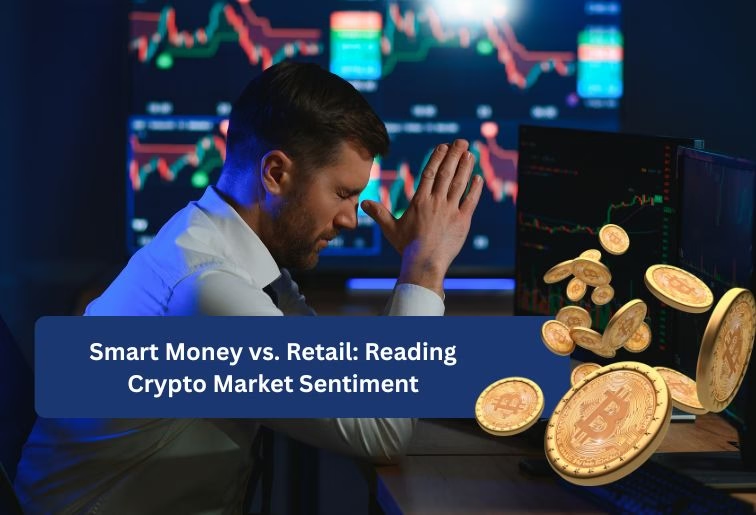The crypto market is a 24/7 market, and with it comes a never-ending dynamic of selling and buying pressure that drives price action. But the most important thing that most traders ignore is the fact that all participants are not equal. Knowing the difference between smart money and retail traders is crucial for anyone who wants to be in a position to read crypto market sentiment.
If you ever find yourself questioning why your meticulously studied trade fails when institutional investors are raking in profit after profit, you’re not alone. The culprit can be attributed to market sentiment—overall attitude and disposition of traders towards a specific cryptocurrency or the market as a whole.
Understanding Market Participants: Who’s Who in Crypto
Smart Money: The Institutional Edge
Smart money are the resources in the possession of institutional investors, hedge funds, market makers, and savvy whales who have better resources, information, and trading infrastructure. They don’t merely respond to crypto sentiment—instead, they assist in shaping it.
Smart money acts with some key benefits:
- Access to advanced analytics and market-making news
- Large trades executed with no immediate price impact
- Well-thought-out positions for the long term and not emotional responses
- Sophisticated risk management systems
Retail Traders: The Emotional Majority
Retail traders are non-institutional investors who trade their own money. Even though collectively strong, retail participants will generally have uniform behavioral patterns motivated by FOMO (fear of missing out), panic selling, and herd behavior. Retail behavior must be interpreted in order to correctly interpret crypto market sentiment.
Key Indicators for Reading Crypto Market Sentiment
On-Chain Metrics Tell the Real Story
Smart money makes tracks. Through analyzing on-chain data, you can see patterns of accumulation and distribution:
Exchange Inflows vs. Outflows: When a large amount of cryptocurrency is leaving exchanges to enter private wallets, it usually is a sign of smart money accumulation—a positive sign. Large exchange inflows usually indicate impending sell-offs.
Tracking Whale Trades: Trades exceeding specific levels (typically $100,000+) indicate institution-level trading. Persistent large accumulations on dips illustrate wise money conviction.
Social Sentiment and Retail Psyche
Retail traders populate social media websites, so they are the perfect place to measure extreme emotions:
Fear & Greed Index: This aggregate metric captures market emotions ranging from extreme fear to extreme greed. Wise money purchases when in extreme fear while retail panic sells.
Social Volume Spikes: Abrupt surges in Twitter, Reddit, and Telegram mentions of cryptocurrencies typically accompany retail FOMO—such as at local highs.
Derivatives Data and Funding Rates
Funding rates on futures show whether overall traders are long or short. Very positive funding rates signal jammed long positions (retail bulls) and tend to cause corrections. Contrarian astute money observers look for these extremes.
Behavioral Patterns: How Smart Money and Retail Differ
Timing and Execution
Smart money builds up during the time of consolidation and downtrend when retail trader enthusiasm wanes. They scatter when euphoric rallies see maximum retail euphoria. This counter-cyclical behavior is the key to reading crypto sentiment like a pro.
Retail traders, on the other hand, buy strength and sell weakness—exactly the opposite of winning methods. They get in after strong moves have already taken place, buying into distribution by smart money.
Information Asymmetry
Institutional participants spend significant amounts of capital on research, have industry sources, and utilize quantitative analysts. They respond to fundamental occurrences ahead of news coming to mainstream media.
Retail traders depend on social media, news aggregators, and crypto influencers—tools that mirror instead of forecasting activity in markets. Smart money already took action when retail receives information.
Real-World Strategies for Improved Sentiment Analysis
Draw from Multiple Sources of Data
Never use one measurement. Solid crypto market sentiment analysis involves consolidating:
- On-chain data (exchange reserves, accumulation addresses)
- Derivatives data (open interest, funding rates)
- Social sentiment (social volume, Fear & Greed Index)
- Technical analysis (volume profiles, support/resistance)
Identify Divergences
The best opportunities arise when sentiment breaks away from price action. Prices, for instance, may fall but whale address aggression from smart money indicating value that retail traders fail to see—a potentially bullish setup.
Track Liquidation Levels
Big liquidation cascades are transient highs. The smart money offers liquidity in the moments of fear and retail traders get stopped out. Heatmaps of liquidation help you foresee areas of volatility.
Begin Crypto Trading with a Sentiment Edge
Market sentiment reading isn’t predicting every move—it’s being in the correct position for big trends. From learning how smart money and retail traders behave uniquely, you’ve got a set of rules to decode market psychology.
Aspiring Trader Key Takeaways:
Smart money follow: Use on-chain analysis to monitor institutional buying patterns
Fade extremes in sentiment: Excessive fear is a buying opportunity; excessive greed is a warning
Think contrarian: When market sentiment has reached panicky or euphoric proportions, go contrary
Prioritize education: Take the time to study market mechanics before risking capital
The crypto market is more in favor of the intelligent who know its emotional rhythms. Smart money never has a crystal ball—they simply better read sentiment signals and are consistent when emotions are involved.
Conclusion: Bridging the Knowledge Gap
The gap between smart money-discount traders isn’t so great. Through finding out what smart money is doing, using proper analysis tools, and achieving emotional control, you can actually enhance your crypto market sentiment reading abilities.
Keep in mind: sound trading isn’t a race against wise money on capital resources—it’s a matter of imitating their analytical and psychological position. Trade cryptocurrencies by sentiment analysis, and you’ll make better trades no matter what the market.
There will always be winners and losers in the market. Crypto sentiment being the determining factor of which group you fall under is something you can understand. Now that you know what to do, the rest is up to you.

